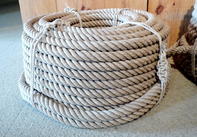Hemp has been cultivated for thousands of years; the first evidence of the use of hemp was found on Taiwanese pottery dating back to 10 000 B.C. In ancient China, thought to be the native country of hemp, hemp - one of the first plants to be used for fibre - was used to weave cloths, shoes, paper and ropes. Hemp was also recommended for a variety of ailments, including constipation, rheumatism, and absentmindedness.

Spreading of Hemp
Of the three species of Cannabis, hemp - the cannabis sativa-type - was first to spread to the rest of the world, probably due to its useful fibres and edible seeds. There is evidence of widespread cultivation in the British Isles around 400 B.C. where the hemp plant was used for cloth (hemp fibres) as well as oil and food (hemp seeds).
Awareness of the intoxicating effects of THC-rich cannabis strains spread beyond medical and industrial circles and motivated the use of these cannabis strains for religious and recreational purposes.
Hemp cannabis was introduced into Canada in 1606 for the manufacture of ropes and sails and was planted in the USA for the first time in the 1630s. Hemp was so widely planted and used in America that it is estimated that half of all clothing was made from hemp in the late 1700s.
The abolition of slavery in the USA and the planting of cotton led to a decline in the cultivation of hemp for cloth. In addition, the use of cheap wood pulp for making paper further limited the use of hemp. It was, however, still used to manufacture cigarette papers, Bibles and money.
Banning of Hemp
Also evolving over time were “marijuana” hemp types with higher levels of THC. These THC-containing strains from southern Asia were used in recreational drugs but unfortunately, industrial hemp became linked with its high-THC cousin.
In the 1930s, after the appointment of Henry J. Anslinger as the commissioner of the newly-established Narcotics Bureau, hemp cannabis was declared a narcotic and hemp farming was banned in the USA.
In the 1940s, producing and processing of hemp was temporarily revived to produced paper, textiles and rope for use during the Second World War, but hemp production permits were repealed after the war.
In recent years, there has been renewed interest in hemp worldwide with France taking the lead - currently the largest producer of industrial hemp in the world. China has registered over 300 hemp-related patents and Canada has legalised the growing of industrial hemp for seed and fibre used for paper, textiles, bio-composites and sustainable building materials.
Hemp in South Africa
In South Africa, the legislation does not distinguish between the growing of Cannabis (dagga) and the growing of industrial hemp. Despite numerous trials and commercialisation of hemp in countries such as Canada, China and France, the industrial growing and processing of hemp is still illegal and special permits are required to plant hemp. This allows hemp production for research purposes only.
Hemp-related products in South Africa are imported.
By Marinda Louw